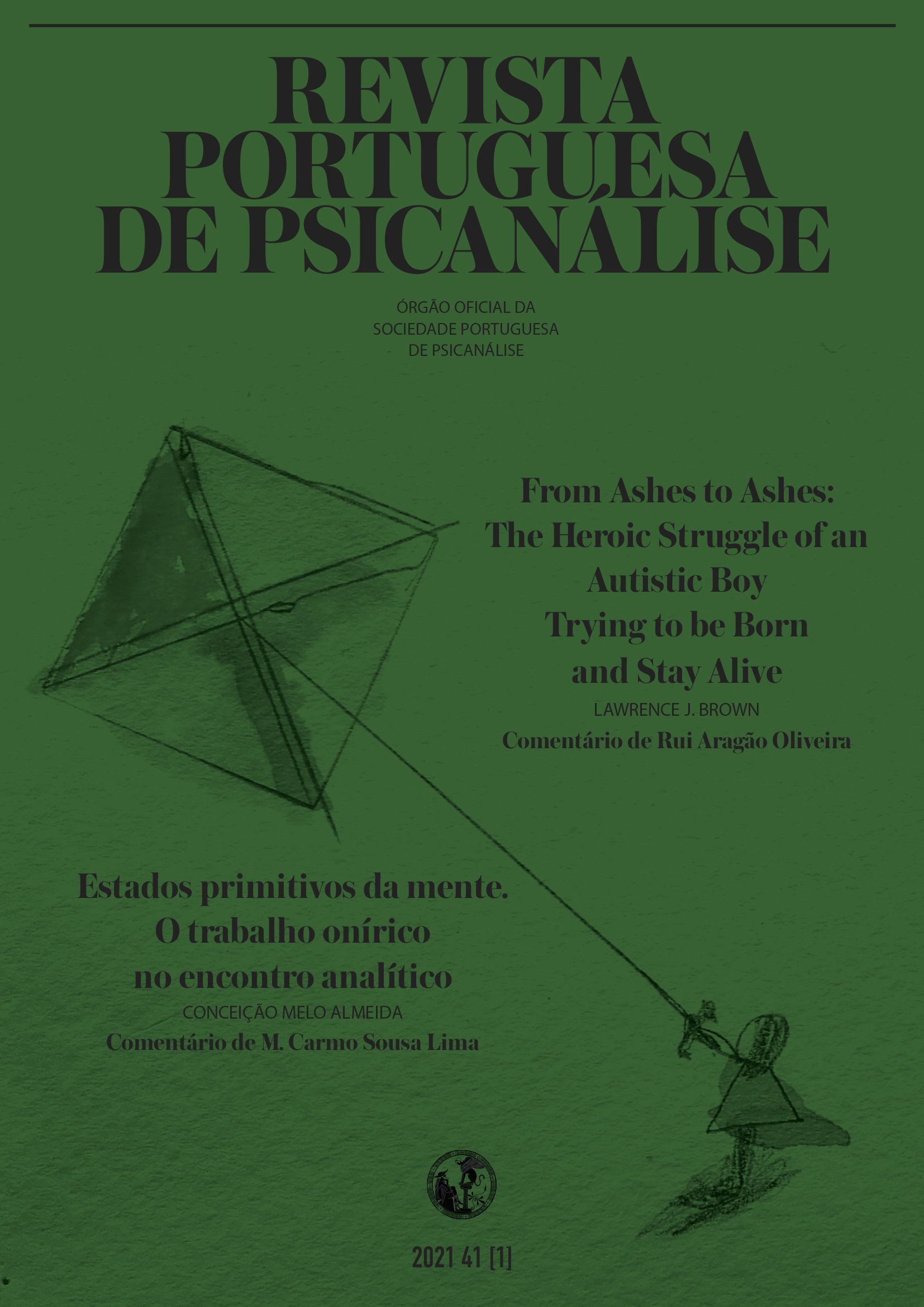A Clínica de Quarentena (a Quatro Mãos): Primeiro Andamento de Uma Psicanálise em Tempos de Pandemia

Abstract
The Clinical Practice in Quarentine (A Four Hands Play): First Movement of Psychoanalysis in Times of Pandemic
With the emergence of the pandemic, in the beginning of 2020, the physical proximity between analyst and analysand became not only prohibited, but dangerous .... Suddenly, analysts were forced to close the office doors, and if some suspended the work with patients, most started work remotely - teleanalysis (by phone or internet - Skype, Zoom, WhatsApp, etc.).
Four analysts reflect on their experience in adjusting the setting in times of a pandemic: the specificity of the pandemic situation in relation to other situations in which the external reality requires the use of the remote setting; the different way in which the pandemic and the necessary alteration of the setting were experienced by different patients, and by different analysts, showing how psychoanalysis works with the analytical field and how each dyad, in the transference-countertransference relationship, makes what happens there unique.
From this multiple experience of four analysts “playing” together their unique experience, just as musicians can play together a single sonata, each with its different melody, it was possible to raise a series of questions at the end.
Keywords
Pandemic, Teleanalysis, Setting Changes
References
- Abraham, N. & Torok, M. (1995). A casca e o núcleo. Escuta. (Obra original publicada em 1972.)
- Aryan, A. (2013). Setting and transference-countertransference reconsidered on beginning teleanalysis. In J. S. Scharff (Ed.), Psychoanalysis online, mental health, teletherapy and training. Karnac Books.
- Bion, W. R. (1970). Attention and interpretation. Karnac Books.
- Cabré, L. M. (2020a). Webminar «Procesamiento de la situación traumática y el aislamiento social», International Psychoanalytical Association, 3 de abril.
- Cabré, L. M. (2020b). El desafio del coronavírus y su manejo clínico. In M. J. Gonçalves; C. Farate; D. Kraunt; L. M. Cabré & R. A. Oliveira, Ética e Psicanálise à Distância. Revista Portuguesa de Psicanálise, 40(2), 77–81.
- Cintra, E. M. (2013). André Green e o trabalho do negativo. Revista Percurso, 49/50, Ano XXV, junho:http://revistapercurso.uol.com.br/index.php?apg=artigo_view&ida=1010&ori=edicao&id_edicao=49
- Dias, C. A. (2004). Costurando as linhas da psicopatologia borderland (estados limite). Climepsi Editores.
- Diena, S. (2020). Entrevista IPA Off the Couch, Ep. 41, 25 de março: http://ipaoffthecouch.org/2020/03/24/episode-41-report-from-milan-with-simonetta-diena-md/
- Ehrlich, L. (2019). Teleanalysis: Slippery slope or rich opportunity? Journal of the American Pyschoanalytic Association, 67: 249–279.
- Fairbairn, R. (2000) Estudos Psicanalíticos da personalidade. Veja.
- Ferenczi, S. (2011). A elasticidade da técnica psicanalítica. In Obras Completas: Psicanálise IV. Martins Fontes. (Trabalho original publicado em 1928.)
- Ferro, A. (2009). Mind Works. Technique and Creativity in Psychoanalysis. General Editor.
- Franco, S. (2003). Psicopatologia e o viver criativo. Revista Latinoamericana Psicopatologia Fundamental, VI(2), 36–50.
- Garcia, C; Penna, C (2010). O Trabalho do Negativo e a Transmissão Psíquica. Arquivos Brasileiros de Psicologia, 62(3):
- http://pepsic.bvsalud.org/scielo.php?script=sci_arttext&pid=S1809-52672010000300009
- Gutiérrez, L. (2017). Silicon in ‘pure gold’? Theoretical contributions and observations on teleanalysis by videoconference. International Journal of Psychoanalysis, 98,1097–1120.
- Hardt, J. (2019). Does Psychoanalysis go online without Body?. EPF Publication “Body”, 73: 83–88.
- Hárs, G.P. (2015) O conceito de paixão no Diário Clínico de Ferenczi. Tempo Psicanalítico, vol. 47.1, 9–21.
- Khan, M (1963). The concept of cumulative trauma. Psychoanaytical Study of the Child, 18, 286–306.
- Kristeva, J. & Scarfone, D. (2020). La situation virale et ses resonances psychanalytiques. International Psychoanalytical Association Webinar.
- Kogan, I (2020). Entrevista IPA Off the Couch, Ep. 67, 27 de setembro: http://ipaoffthecouch.org/2020/09/27/episode-67-creativity-in-the-analyst-and-analysand-in-times-of-covid-with-ilany-kogan/
- Komarova, L. (2020). Entrevista IPA Off the Couch, Ep. 57, 28 de junho: http://ipaoffthecouch.org/2020/06/28/episode-57-a-report-from-moscow-and-the-role-of-denial-with-lola-komarova-ph-d/
- Lemma, A. (2014). The body of the analyst and the analytic setting: Reflections on the embodied setting and the symbiotic transference. International Journal of Psychoanalysis, 95, 225–244.
- Lemma, A. (2015). Psychoanalysis in the time of technoculture: Some reflections on the fate of the body in virtual space. The International Journal of Psychoanalysis, 96, 569–582.
- Marta, R. (2011). A Linguagem do Silencio: transformando analista e paciente. Revista Portuguesa de Psicana?lise, 30(2),
- Marta, R. (2016). Relações reais e/ou virtuais? A psicanálise remota. Revista Portuguesa de Psicanálise, 37(2),
- Marta, R. (2019). O analista tem corpo? Transformações do corpo em análise. Revista Portuguesa de Psicanálise, 40(1), 42–51.
- Marta, R. (2020). O Real, o Tempo e o Espaço em Tempos de Corona. A Peste – Blogue da Sociedade Portuguesa de Psicanálise. Maio.
- Matos, A. C. (2014). Depressão. Climepsi Editores.
- Miguez, T. (2021). Desafios à Psicanálise e à sua Criatividade. A Peste – Blogue da Sociedade Portuguesa de Psicanálise. Março.
- Miller, J. A. (2004). Uma fantasia. Opção Lacaniana. Eolia, 42(3,) 7–18.
- Miller, P. (2019). Working Through the Body Ego in the Analytic Process. EPF Publication “Body”, 73, 134–141.
- Nacht, S. (1964). Silence as an integrative factor. The International Journal of Psychoanalysis, 45(2/5), 299–303.
- Ogden, T. H. (1985). On potential space. International Journal of Psychoanalysis, 66(2), 129–141.
- Ogden, T. H. (2010). Esta Arte da Psicanálise. Artmed Editora.
- Samuel, Y. (2020). Entrevista IPA Off the Couch, Ep .41, 26 de abril:
- http://ipaoffthecouch.org/2020/04/26/episode-49-a-report-from-tel-aviv-with-yael-samuel-phd/
- Scarfone, D. (2015). The time before us. (The Unpast in W. S. Merwin, W. Benjamin and V. Woolf.). Psychoanalytical Dialogues, 26(5), 513–520.
- Scharff, J. (2012). Clinical issues in analyses over the telephone and the internet. International Journal of Psychoanalysis, 93, 81–95.
- Winnicott, D. (1967). O brincar e a realidade. Imago.
- Winnicott, D. W. (1983). O desenvolvimento da capacidade de se preocupar. In D. W. Winnicott, O ambiente e os processos de maturação: estudos sobre a teoria do desenvolvimento emocional (pp. 70–78). Artes Médicas. (Obra original publicado em 1963.)